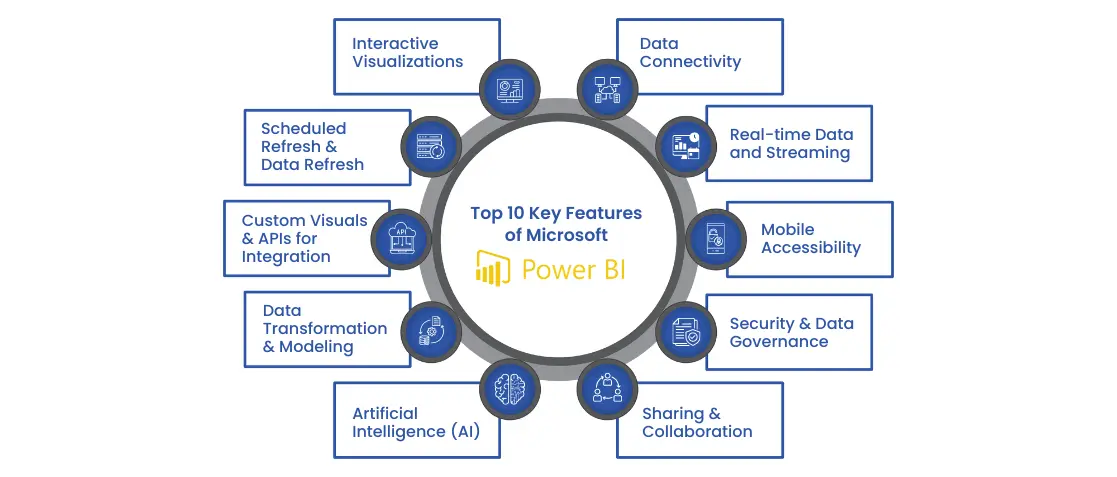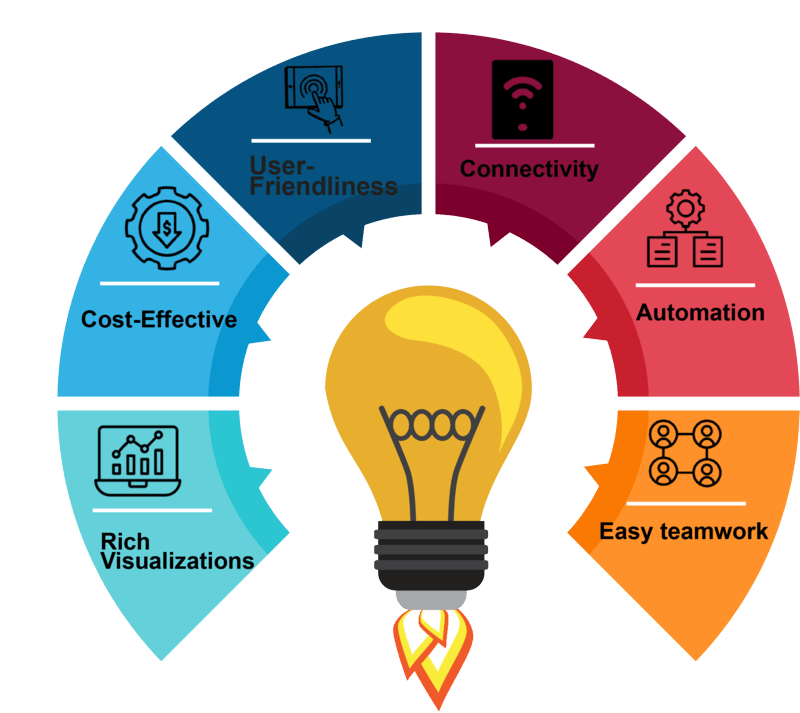
- Introduction
- Understanding Business Intelligence (BI)
- The Rise of Power BI
- Key Features of Power BI
- Power BI vs.Traditional BI Tools
- How Power BI is Enhancing Decision-Making
- The Impact of Power BI on Businesses of All Sizes
- The Future of Power BI and BI in the Digital Age
- Conclusion
Introduction
In today’s fast-paced, data-driven environment, organizations rely heavily on business intelligence (BI) tools to stay ahead of the competition. With the growing volume of data being produced across industries, businesses need powerful solutions to gather, process, and interpret this information effectively. Microsoft Power BI stands out as a leading BI tool, empowering both large enterprises and small businesses to make smarter, data-informed decisions. Its user-friendly interface, robust data integration capabilities, and interactive visualizations allow users to uncover insights quickly and easily. For professionals looking to strengthen their skills in data analysis and reporting, Business Analyst Training can be a valuable step toward mastering tools like Power BI. Power BI also supports real-time analytics and seamless collaboration, helping teams stay aligned and agile. This blog delves into the key features and benefits of Power BI, highlighting how it is transforming the way companies approach data analytics and business strategy, making intelligent decision-making more accessible, scalable, and impactful than ever before.
Understanding Business Intelligence (BI)
Business Intelligence (BI) refers to technologies, processes, and tools that help organizations collect, analyze, and present business data. BI solutions help companies make informed decisions by turning raw data into actionable insights. Traditionally, BI tools involved complex processes requiring specialized IT knowledge, but modern BI platforms like What is Power BI and Its Application have made these insights more accessible and user-friendly for a broader audience.
A well-implemented BI system can:
- Improve decision-making processes
- Identify new market trends
- Optimize operations
- Increase profitability and productivity
In the past, BI tools were often used only by large enterprises. Still, today, with tools like Power BI, smaller companies can also tap into the power of data analytics, driving growth and innovation.
Become a Business Analyst by enrolling in this Business Analyst Online Course today.
The Rise of Power BI
Microsoft Power BI is a cloud-based business analytics service that enables users to visualize data, share insights, and collaborate within their organization. Launched in 2013, Power BI has quickly gained popularity due to its robust features, ease of use, and integration with Microsoft tools like Excel, Azure, and Office 365. With its intuitive interface and extensive features, Power BI democratizes data access, making it easy for employees at all levels to analyze and make sense of data. For professionals aiming to build expertise in tools like Power BI, Business Analyst Training offers essential skills to interpret data effectively and support informed decision-making.
Some of the reasons for Power BI’s rise include:
- Affordability: Power BI offers a low-cost entry point compared to traditional BI tools, making it attractive to small and medium-sized businesses.
- Integration with Microsoft Ecosystem: Many organizations already use Microsoft products, making Power BI a natural fit due to its seamless integration with services like Excel, SharePoint, and SQL Server.
- User-Friendly Interface: With a drag-and-drop interface and pre-built templates, users can create professional dashboards and reports without needing specialized coding knowledge.
Power BI’s rise is not just a trend; it represents a broader shift in the BI landscape, where businesses are looking for solutions that offer flexibility, ease of use, and integration with other essential business tools.
Thinking About Earning a Master’s Degree in Business Analyst ? Enroll For Business Intelligence Master Program Training Course Today!
Key Features of Power BI
Power BI stands out for its user-friendliness, advanced analytics capabilities, and robust features. Some key features include:
- Data Connectivity and Integration: Power BI connects to many data sources, from on-premises databases like SQL Server to cloud-based sources such as Google Analytics, Salesforce, and even social media platforms. This connectivity allows businesses to unify their data for comprehensive analysis.
- Interactive Dashboards: : Power BI dashboards allow users to interact with the data in real time. By drilling down into specific data points, users can gain deeper insights into business performance without needing to create new reports or queries. For those looking to build a strong foundation in data analysis, Business Analytics with Excel Fundamentals is a great starting point to understand core concepts before diving into tools like Power BI.
- Customizable Reports: Power BI allows users to create highly customized reports that meet specific business needs. These reports can be tailored to different teams, industries, or metrics.
- Natural Language Queries: Power BI’s natural language processing (NLP) capabilities allow users to type questions in plain English to retrieve data insights. This makes data analysis more accessible to those who are not familiar with complex query languages.
- Data Security and Governance: Security is paramount in today’s digital age. Power BI offers robust data security features, including role-based access control (RBAC), ensuring that only authorized users can access sensitive information.
- Collaboration Tools: Power BI integrates with Microsoft Teams, SharePoint, and other collaboration tools, allowing teams to collaborate on reports and dashboards in real-time. This facilitates more efficient decision-making and collaboration.
- Artificial Intelligence (AI) Features: Power BI incorporates AI-driven insights, such as automatic data insights, anomaly detection, and predictive analytics. These features enable businesses to uncover hidden patterns in their data and make proactive decisions.
Preparing for YourBusiness Analyst Interview? Check Out Our Blog on Business Analyst Interview Questions & Answer

Power BI vs.Traditional BI ToolsPower BI vs.Traditional BI Tools
Before the rise of modern BI platforms like Power BI, traditional business intelligence tools such as SAP BusinessObjects and IBM Cognos demanded extensive technical expertise, involved complex setups, and came with high licensing costs and lengthy training requirements. Power BI, a key component of Microsoft Business Intelligence , has revolutionized the BI space by offering a user-friendly experience tailored for non-technical users, featuring an intuitive drag-and-drop interface and customizable dashboards. Unlike traditional BI tools that often require IT support for report generation, Power BI empowers end users to independently create and manage reports. Its cost-effective subscription model, including a free version for individuals and affordable plans for organizations, contrasts sharply with the expensive and complex pricing of older systems. As a cloud-based platform, Power BI allows access to dashboards from anywhere, eliminating the need for on-premises infrastructure. It integrates seamlessly with other Microsoft products, enhancing productivity through familiar tools, and its rapid implementation time makes it far more agile than traditional solutions. While legacy BI tools still serve large enterprises with intricate data demands, Power BI’s accessibility, affordability, and adaptability have made it the preferred choice for modern businesses aiming for efficient, data-driven decision-making.
How Power BI is Enhancing Decision-Making
One of the most significant impacts of Power BI on the business intelligence landscape is its ability to enhance decision-making. With tools like Power BI Desktop users can visualize data in a variety of formats, such as bar charts, line graphs, maps, and scatter plots, enabling business leaders to easily identify trends and patterns in their data. These visualizations help to answer critical business questions like…
- What products are performing the best?
- Which marketing campaigns are driving the most sales?
- What are the bottlenecks in our supply chain?
By providing an accessible and user-friendly interface, Power BI empowers decision-makers to base their actions on real-time data rather than gut instinct or outdated reports. Additionally, the ability to drill down into data allows users to identify the root causes of issues, making it easier to address challenges proactively.

The Impact of Power BI on Businesses of All Sizes
Power BI’s impact on businesses goes beyond just large enterprises. Small and medium-sized businesses (SMBs) have also embraced Power BI for its cost-effectiveness and scalability. Here’s how Power BI benefits businesses of different sizes:
- For Large Enterprises: Large organizations can take advantage of Power BI’s scalability, advanced analytics features, and integration with existing systems like ERP and CRM platforms. The enterprise version of Power BI allows for sophisticated data models and complex reporting. For those exploring broader solutions, Best Big Data Visualization Tools can offer additional insights into platforms that support large-scale data analysis and visualization.
- For Small and Medium Businesses (SMBs): SMBs benefit from Power BI’s affordability and ease of use. With a low entry cost and no need for extensive IT support, SMBs can quickly start leveraging data to improve business operations, customer experience, and profitability.
Power BI has helped democratize business intelligence, leveling the playing field and enabling businesses of all sizes to make data-driven decisions.
The Future of Power BI and BI in the Digital Age
As businesses continue to generate and rely on more data, the future of business intelligence is bright. Power BI is continuously evolving, with new features being added regularly. Some trends to watch in the future include:
- Integration with Advanced AI and Machine Learning: As AI becomes more integrated into BI tools, Power BI will continue to expand its capabilities in predictive analytics, anomaly detection, and other advanced features.
- Self-Service BI: Power BI will further enable the self-service BI model, where users can create reports and dashboards without relying on IT departments. This empowers employees at all levels to explore and analyze data independently.
- Increased Mobile Access: Power BI will continue to improve its mobile capabilities, allowing users to access data and insights on the go.
The future of BI, driven by tools like Power BI, will be characterized by greater automation, deeper insights, and more personalized experiences for users.
Conclusion
Power BI has revolutionized the business intelligence landscape by offering a powerful yet user-friendly and cost-effective solution for data analysis and reporting. Its seamless integration with Microsoft products, intuitive dashboards, and real-time collaboration features make it a valuable asset for businesses of all sizes and industries. Power BI enables users to transform raw data into meaningful insights through visually rich and interactive reports that require minimal technical expertise. For those looking to build skills in tools like Power BI, Business Analyst Training can be an essential step toward mastering data analysis and reporting. As organizations increasingly rely on data to guide strategic decisions, tools like Power BI empower teams to access, analyze, and share information quickly and efficiently. Its cloud-based nature adds flexibility, allowing access from anywhere, while its scalability ensures it grows with business needs. As the demand for actionable insights continues to surge in today’s data-centric environment, Power BI stands out as a leading platform, equipping companies with the tools they need to make smart, informed decisions and accelerate growth.


